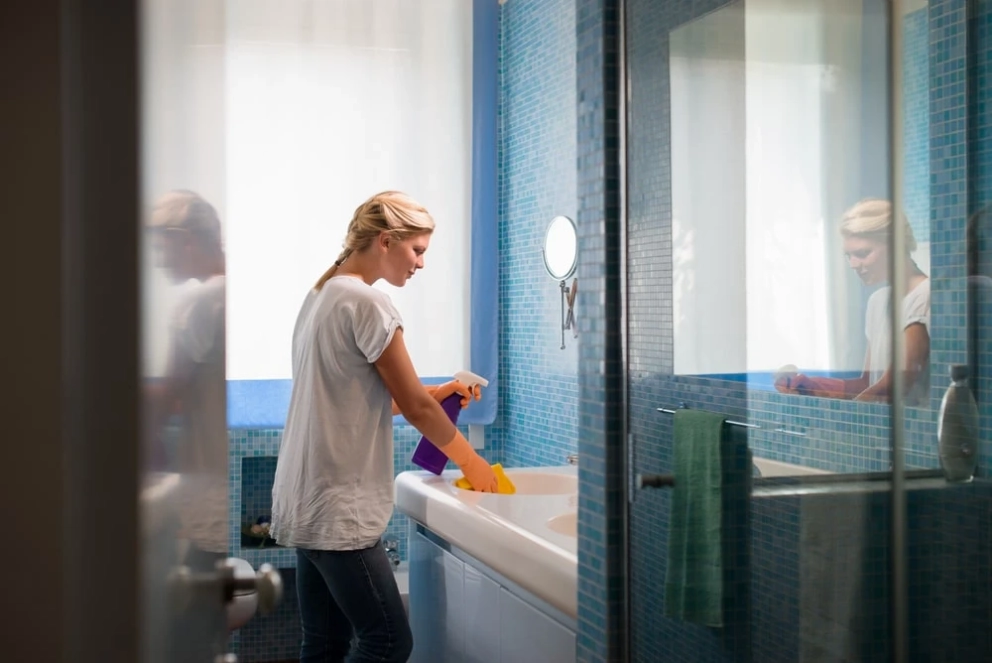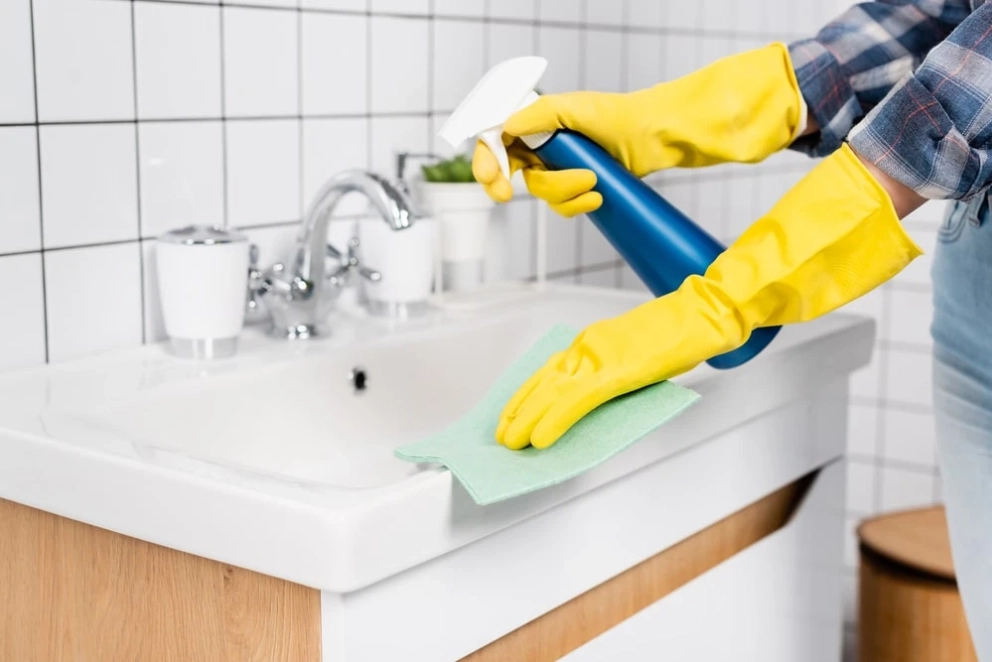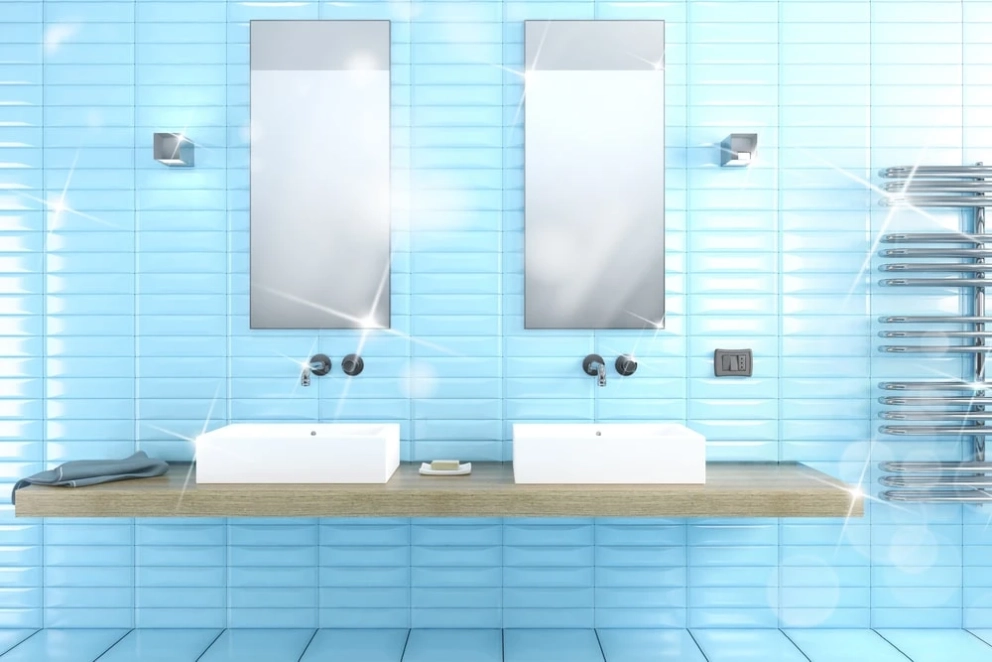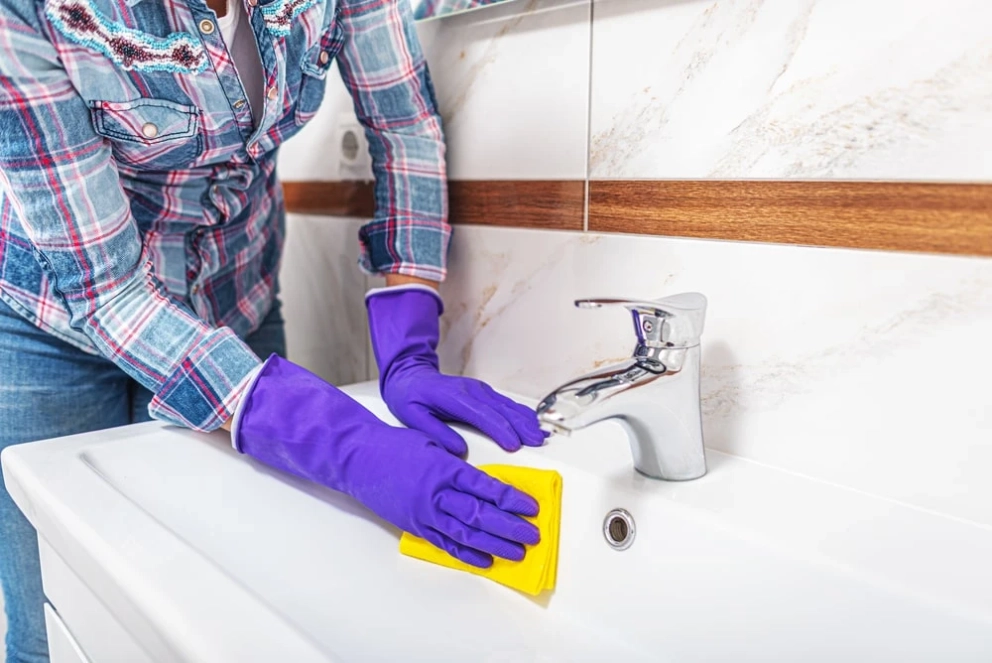Ultimate Guide to Bathroom Cleaning. A Step-by-Step Checklist

Nobody is excited to clean a bathroom, and it's a task that often gets relegated to the bottom of our cleaning to-do lists. The thought of scrubbing away soap scum and tackling mysterious stains can be rather unappealing. However, as necessary as it may be, self-cleaning the bathroom doesn't have to be a chore that leaves you feeling disgusted and drained. In fact, it can become a breeze when you know some cleaning hacks for the bathroom, the right steps to follow and the best techniques to use.
This blog is your secret weapon for transforming your bathroom cleaning routine from a dreaded duty into a manageable and even satisfying task. You'll find bathroom cleaning hacks, expert tips, thorough checklists, and practical advice to help you clean your bathroom more effectively and efficiently. Be sure to bookmark this guide for future reference, as you'll want to keep coming back to it every time you step into your bathroom with cleaning in mind. Let's turn that bathroom sparkle into reality!
Bathroom deep cleaning checklist
Before embarking on the mission of deep cleaning your bathroom, take a moment to prepare a bathroom cleaning list that will transform the often-daunting task into a breeze. Having a checklist is an essential step in ensuring that you don't miss any key areas or forget important tasks. It helps you stay organized, save time, and make the cleaning process more efficient.
In the upcoming blog sections, we'll delve into the finer details of bathroom deep cleaning, starting with the optimal order of cleaning, followed by a discussion on the must-have bathroom cleaning tools, and finally, we'll share a treasure trove of tips and hacks that will make your bathroom cleaning experience not only effective but also surprisingly enjoyable.
Order of cleaning bathroom

Cleaning a bathroom doesn't have to be a complicated ordeal when you follow a systematic order. By tackling each area in a logical sequence, you can make the process not only more efficient but also more effective. So, let's break down the steps in cleaning your bathroom in a way that ensures no corner is left unattended.
- Clear clutter
Before you dive into any cleaning tasks, start by decluttering the bathroom. Remove all items from countertops, shelves, and the shower area. This not only allows for more thorough cleaning but also helps you get a clearer view of what needs attention.
- Dusting and cobweb removal
Begin by dusting and removing any cobwebs. Dust light fixtures, vents, and corners using a long-handled duster or a microfiber cloth. The idea is to prevent dust from falling onto freshly cleaned surfaces later in the process.
- Mirrors and glass surfaces
Spritz glass cleaner on your mirrors and glass surfaces. Wipe them down using a lint-free cloth or paper towel. To avoid streaks, start from the top and work your way down, overlapping your strokes slightly.
- Countertops and cabinets
Wipe down your countertops and cabinet fronts with an all-purpose cleaner. Pay special attention to faucets and handles, which are often touched frequently. If there are stubborn spots, a mixture of equal parts white vinegar and water can be effective.
- Toilet bowl and seat
Apply toilet bowl cleaner inside the bowl, allowing it to sit for 30 minutes. Meanwhile, clean the exterior of the toilet, including the seat and flush handle, with a disinfectant or antibacterial spray. Scrub the bowl with a toilet brush, making sure to reach under the rim and into the trap. After scrubbing, flush the toilet to rinse the bowl.
- Shower and bathtub
For your shower and bathtub, apply an abrasive cleaner. Scrub tiles, grout, and fixtures, paying extra attention to soap scum and mildew. Rinse thoroughly with water to remove all residue.
- Tiles and grout
Inspect the tiles and grout throughout the bathroom. If you notice any discoloured or mouldy areas, use a mixture of equal parts water and white vinegar to scrub them clean. For stubborn stains, consider using a specialized grout cleaner.
- Floors
Sweep or vacuum the bathroom floor to remove debris. Then, mop the floor using a suitable floor cleaner. Pay extra attention to grout lines and corners, as these areas tend to accumulate dirt and grime. If your bathroom has tile floors, make sure to use a cleaner that is safe for tiles.
- Disinfect high-touch areas
Finally, disinfect high-touch areas like doorknobs, light switches, and faucet handles with an antibacterial or disinfectant spray. These areas can harbour germs and should be regularly sanitized to maintain a hygienic environment.
Hard-to-reaches and delicate areas

Cleaning those hard-to-reach areas in the bathroom can be a challenge, but with the right approach and tools, you can make it much easier. Here are practical tips on how to clean these hard-to-reach areas in your bathroom.
- Cleaning bathroom sink drain and removing clogs
Bathroom sink drain cleaning is the first step when cleaning a clogged bathroom sink. Start by removing any visible debris or hair from the drain using needle-nose pliers. Next, pour a mixture of half a cup of baking soda and half a cup of white vinegar down the drain, allowing it to fizz and break down the clog for about 10-15 minutes.
Finally, flush the drain with hot water to clear any remaining debris and test the flow. If the clog persists, consider using a sink plunger or a drain snake or remove the sink stopper. To remove the bathroom sink stopper for cleaning, locate the pivot rod beneath the sink and unscrew the nut that secures it to the drain. Once the pivot rod is disconnected, gently pull the stopper out from the top of the sink.
After cleaning the stopper, reassemble it by inserting it back into the drain, reattaching the pivot rod, and securing it with the nut. Bathroom drain cleaning should be done at least once a month to make sure that hair and debris will not accumulate. Otherwise, bathroom drainage cleaning will be much more difficult.
- Bathroom vent cleaning
Cleaning the bathroom exhaust fan is essential for maintaining proper air quality. Start by turning off the power to the fan to ensure safety. Then, remove the cover or grille to access the fan blades. Use a vacuum cleaner with a brush attachment to remove dust and debris from the blades and surrounding areas. For more thorough bathroom fan cleaning, dampen a cloth or sponge with a mixture of warm, soapy water and wipe down the blades and housing. Make sure the fan is completely dry before reattaching the cover, and consider cleaning a bathroom fan at least twice a year to keep it functioning efficiently and prevent dust buildup.
- Cleaning bathroom tile grout on floor and walls
Cleaning bathroom grout is perhaps the most daunting task in bathroom cleaning. However, cleaning bathroom tiles is also the most important and frequent area to clean as bathroom tiles accumulate bacteria fast because it is often wet. To clean bathroom tile walls and floor, start by mixing a paste of equal parts baking soda and water, or use a commercial grout cleaner. Apply this paste to the grout lines and let it sit for 5-10 minutes to loosen dirt and stains. Then, scrub the grout with a grout brush, an old toothbrush, or a scrubbing pad. Rinse with water and wipe away any residue. For more stubborn stains, you can use a mixture of equal parts water and white vinegar. Once the grout is clean, consider applying a grout sealer to help prevent future staining.
Cleaning bathroom walls and cleaning bathroom floor tiles should be done at least once a month. When doing bathroom tile cleaning, make sure it is deep cleaned. If you see stains accumulating fast, do not wait and scrub and stain it right away to remove it fast.
- Cleaning mould in bathroom ceiling
To clean mould on a bathroom ceiling, mix a solution of one part white vinegar and one part water in a spray bottle. Spray the affected area generously and let it sit for at least 15 minutes to break down the mould. Then, scrub the mould with a brush or sponge. For more stubborn mould, consider using a mixture of water and hydrogen peroxide (in a 1:1 ratio) or a specialized mould remover. Be sure to wear protective clothing, such as gloves and a mask, and ensure the bathroom is well-ventilated while cleaning. After removing the mould, rinse the area with clean water and ensure it's completely dry to prevent future mould growth.
- Bathroom glass cleaning
To clean glass surfaces in the bathroom, such as a glass shower door and mirrors, start by spraying the glass with a mixture of equal parts water and white vinegar or a commercial glass cleaner. Use a lint-free cloth, paper towel, or a squeegee to wipe the glass in a circular or up-and-down motion for cleaning bathroom mirrors and top-to-bottom for cleaning a bathroom glass door and a shower door. This will help prevent streaks. For stubborn spots or soap scum on the shower door, you can use a paste made of baking soda and water to gently scrub the area. Ensure the glass is completely dry and buffed for a sparkling, streak-free finish.
- Cleaning bathroom vanity
To clean a bathroom vanity, you need to check thoroughly the fixtures and do deep bathroom taps cleaning. Start by clearing the area and removing any items around the taps. Then, use a mixture of mild dish soap and warm water to clean the vanity surface and taps, wiping with a damp cloth. For any stubborn spots or mineral deposits on the taps, a solution of equal parts water and white vinegar can be used, followed by rinsing and drying thoroughly to restore their shine. Consider sealing a surface to make your bathroom vanity waterproof.
- Cleaning quartz countertops in the bathroom
Cleaning bathroom countertops that are made of granite, marble and quartz requires specific care to maintain their beauty. For cleaning marble countertops bathroom, start by wiping up spills promptly with a soft, damp cloth to prevent staining. The same goes for cleaning bathroom granite countertops and cleaning quartz bathroom countertops. For daily cleaning, use a mixture of warm water, mild dish soap, and a soft cloth to wipe down the surface. Avoid abrasive or acidic cleaners, such as vinegar, as they can damage the surfaces. For deeper cleaning, you can use a pH-balanced stone cleaner for cleaning marble bathroom countertops and a gentle cleaner for quartz. Always rinse thoroughly and dry with a clean, soft cloth to prevent water spots or streaks. To protect the surfaces, consider using coasters for toiletries and trivets for hot items to prevent damage.
- Bathroom closet cleaning
To clean a bathroom closet or cabinets, start by removing the contents and decluttering the space. Wipe down the interior surfaces with a mixture of warm water and mild dish soap, then rinse and dry thoroughly. When cleaning bathroom cabinets made of wood, you can use a specialized wood cleaner, and for laminate or painted cabinets, a gentle all-purpose cleaner is suitable. Reorganize and return items to their places once the cabinets are dry.
Bathroom cleaning tools

These cleaning tools for the bathroom are necessary for a thorough and effective bathroom cleaning routine, ensuring that each area in the bathroom receives the attention it needs while also maintaining cleanliness and hygiene.
| Tool | Description |
| Steam cleaner | A steam cleaner uses high-temperature steam to disinfect and clean bathroom surfaces. Steam cleaning bathroom is effective in killing germs, removing soap scum, and tackling grout stains without the need for chemical cleaners. It's especially useful for tile and grout cleaning. |
| Bathroom cleaning wipes | Cleaning wipes are convenient for quick touch-ups and disinfecting high-touch surfaces like faucets, doorknobs, and light switches. They often come pre-moistened with cleaning solutions and are disposable for easy cleanup. |
| Cleaning brush | A variety of brushes, including scrub brushes, grout brushes, and toilet bowl brushes, are essential for scrubbing away grime, mildew, and stains from different bathroom surfaces. They provide the necessary scrubbing power to achieve a thorough clean. |
| Gloves | Rubber or latex bathroom cleaning gloves protect your hands from cleaning chemicals and water exposure. They also provide a barrier against germs and contaminants in the bathroom, ensuring your safety while cleaning. |
| Microfiber cloths | Microfiber cloths are effective for wiping down and polishing bathroom surfaces. They are highly absorbent, lint-free, and can be used for mirrors, countertops, and fixtures. |
| Squeegee | A squeegee is a must for keeping glass surfaces, such as shower doors and mirrors, streak-free. It helps remove water and soap residue efficiently, leaving a sparkling finish. |
| Toilet brush and holder | A dedicated toilet brush for cleaning the bathroom is crucial for cleaning and disinfecting the toilet bowl, while the holder keeps it tidy and hygienic between uses. |
| Dustpan and broom | For sweeping up debris and dust on the bathroom floor or in the closet. It's the first step in the cleaning process and keeps your workspace clear. |
Eco-friendly bathroom cleaning tips

If you're looking to clean your bathroom without harsh chemicals, it's time to explore the realm of eco-friendly bathroom cleaning products and homemade bathroom cleaning products. You may craft your eco-friendly bathroom cleaning products with simple ingredients found in your pantry. Let's dive into some eco-friendly bathroom cleaning hacks with vinegar and other household items.
Vinegar for cleaning the bathroom
Vinegar, a versatile and eco-friendly bathroom cleaning agent, can tackle a variety of bathroom surfaces. Mix equal parts of water and vinegar in a spray bottle to clean mirrors and glass surfaces. Cleaning the bathroom with vinegar helps break down soap scum and water spots, leaving behind a streak-free shine. To remove stubborn grout stains, apply vinegar directly and scrub with a brush.
Cleaning bathroom with baking soda
Baking soda, when combined with vinegar, forms a dynamic eco-friendly duo for bathroom cleaning. Sprinkle baking soda in the toilet bowl, add vinegar, and let it fizz to dissolve stains and odours. Baking soda can also be used to scrub sinks, countertops, and tile grout. Its gentle abrasiveness is tough on grime but safe for various surfaces.
Hydrogen peroxide for cleaning bathroom
Hydrogen peroxide is a natural disinfectant that can effectively sanitize bathroom surfaces. It's particularly useful for eliminating germs and mould. Simply apply it to areas that need disinfection and let it sit for a few minutes before wiping clean.
Cleaning the bathroom with shaving cream
Did you know that shaving cream can be a handy bathroom cleaning tool? Its foamy consistency makes it perfect for cleaning mirrors and glass surfaces. Apply a small amount, spread it evenly, and then wipe it away to reveal a sparkling finish.
Bathroom steam cleaning
For a more eco-friendly deep clean, consider using a bathroom steam cleaner. Steam cleaning is a chemical-free way to sanitize and disinfect bathroom surfaces, including tile, grout, and fixtures, while also blasting away grime and mildew.
Cleaning the bathroom with ammonia
Ammonia is an effective yet strong cleaner. While not entirely eco-friendly due to its harsh fumes, it can be used in a well-ventilated bathroom to remove tough stains, but it should be used sparingly and with caution.
In your quest for a greener and cleaner bathroom, embracing these eco-friendly bathroom cleaning methods and products can contribute to a healthier and more sustainable living environment. Plus, you'll discover that these natural solutions can be just as effective as their chemical counterparts, all while being kinder to both your bathroom and the planet.


